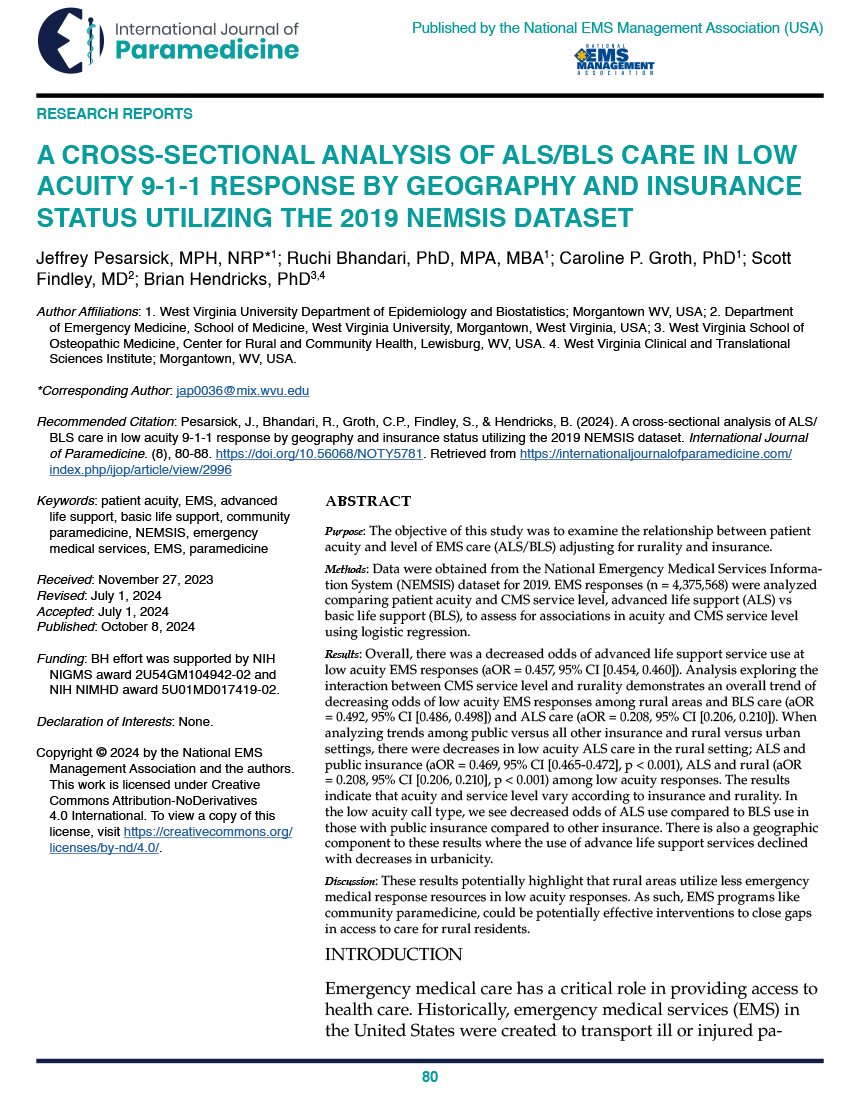A Cross-Sectional Analysis of ALS/ BLS Care in Low Acuity 9-1-1 Response by Geography and Insurance Status Utilizing the 2019 NEMSIS Dataset
Main Article Content
Abstract
Purpose. The objective of this study was to examine the relationship between patient acuity and level of EMS care adjusting for rurality and insurance.
Methods. Data were obtained from the National Emergency Services Information System (NEMSIS) database for 2019. EMS responses (n = 4,375,568) were analyzed comparing patient acuity and CMS Service level, Advanced Life Support (ALS) vs Basic Life Support (BLS), to assess for associations in acuity and CMS Service level using logistic regression.
Results. Overall, there was a decreased odds of advanced life service use at low acuity EMS responses (OR=0.443, 95% CI=0.440-0.445). Sub analysis exploring the interaction between CMS Service Level, Rurality demonstrates an overall trend of decreasing odds of low acuity EMS responses among rural areas and BLS care (OR=0.492, 95% CI=0.486,0.498) and ALS care (OR=0.198, 95% CI=0.197,0.200). When analyzing trends among public vs all other insurance and rural vs urban settings, there were decreases in low acuity ALS care in the rural setting; ALS and Pub Insurance (OR 0.447, 0.444-0.450, p<0.001), ALS and Rural (OR 0.198, CI 0.197-0.914, p<0.001) among low acuity responses. The results indicate that acuity and service level vary according to insurance and rurality. In the low acuity call type, we see decreased odds of ALS use compared BLS use in those with public insurances compared to other insurance. There is also a geographic component to these results where the use of Advance Life Support services declined with decreases in urbanicity.
Discussion. These results potentially highlight that rural areas utilize less emergency medical response resources in low acuity responses. As such, EMS programs like community paramedicine, could be potentially effective interventions to close gaps in access to care for rural residents.
Article Details

This work is licensed under a Creative Commons Attribution-NoDerivatives 4.0 International License.
Publishing in IJOP allows authors to keep their copyright while giving IJOP unrestricted copyright permissions. Articles published in IJOP use Creative Common Attribution 4.0 International (CC BY-ND 4.0) licensing. This license requires that re-users give credit to the creator. It allows re-users to copy and distribute the material in any medium or format in unadapted form only, even for commercial purposes. Additional terms apply and can be accessed here.
Publishing in IJOP also allows authors to have contracts for non-exclusive distribution of the Journal's published version of the article, such as posting to an institutional repository or publication in a book, on the condition that the original publication in the original layout format in IJOP is retained and acknowledged.
We permit and encourage authors to post the articles they published in IJOP on their affiliated websites. This helps share the information, encourages citation in other works, and promotes scholarly discourse in the spirit of open access.
References
Alanazy, A. R. M., Wark, S., Fraser, J., & Nagle, A. (2019). Factors impacting patient outcomes associated with use of emergency medical services operating in urban versus rural areas: A systematic review. International Journal of Environmental Research and Public Health, 16(10). https://doi.org/10.3390/ijerph16101728
Alpert, A., Morganti, K. G., Margolis, G. S., Wasserman, J., & Kellermann, A. L. (2017). Giving EMS flexibility in transporting low-acuity patients could generate substantial Medicare savings. Health Affairs, 32(12), 2142–2148. https://doi.org/10.1377/hlthaff.2013.0741
Beeson, M. S., Ankel, F., Bhat, R., Broder, J. S., Dimeo, S. P., Gorgas, D. L., Jones, J. S., Patel, V., Schiller, E., Ufberg, J. W., & Keehbauch, J. N. (2020). The 2019 Model of the Clinical Practice of Emergency Medicine. Journal of Emergency Medicine, 59(1), 96–120. https://doi.org/10.1016/j.jemermed.2020.03.018
Deziel, N. C., Warren, J. L., Bravo, M. A., Macalintal, F., Kimbro, R. T., & Bell, M. L. (2023). Assessing community-level exposure to social vulnerability and isolation: Spatial patterning and urban-rural differences. Journal of Exposure Science & Environmental Epidemiology, 33(2). https://doi.org/10.1038/S41370-022-00435-8
Duong, H. V., Herrera, L. N., Moore, J. X., Donnelly, J., Jacobson, K. E., Carlson, J. N., Mann, N. C., & Wang, H. E. (2017). National characteristics of emergency medical services responses for older adults in the United States. Prehospital Emergency Care, 22(1), 7–14. https://doi.org/10.1080/10903127.2017.1347223
Durant, E. & Fahimi, J. (2012). Factors associated with ambulance use among patients with low-acuity conditions. Prehospital Emergency Care, 16(3), 329–337. https://doi.org/10.3109/10903127.2012.670688
Eberhardt, M. S., Ingram, D. D., & Makuc, D. M. (2002). The effects of socioeconomic status on health in rural and urban america. JAMA, 287(1), 109–109. https://doi.org/10.1001/jama.287.1.109-JMS0102-3-1
Iglehart, J. K. (2018). The challenging quest to improve rural health care. New England Journal of Medicine, (378)5. https://doi.10.1056/NEJMhpr1707176
Lerner, E. B., & Moscati, R. M. (2001). The golden hour: Scientific fact or medical “urban legend”? Academic Emergency Medicine, 8(7), 758–760. https://doi.org/10.1111/J.1553-2712.2001.TB00201.X
McLaughlin, C., Riutta, O., & Busko, J. (2021). Rural EMS workforce: A call to action.
National Association of State EMS Officials (NASEMSO). (2016). Extended data definitions.
National Association of State EMS Officials (NASEMSO). (2020). 2020 national emergency medical services assessment.
National Emergency Medical Services Information System (NEMSIS). (2020). History of NEMSIS. https://nemsis.org/what-is-nemsis/history-of-nemsis/
National Highway Traffic Safety Administration (NHTSA). (2005). National EMS core content (Publication DOT HS 809 898). https://www.ems.gov/pdf/education/EMS-Education-for-the-Future-A-Systems-Approach/National_EMS_Core_Content.pdf
Newgard, C. D., Fu, R., Bulger, E., Hedges, J. R., Mann, N. C., Wright, D. A., Lehrfeld, D. P., Shields, C., Hoskins, G., Warden, C., Wittwer, L., Cook, J. N. B., Verkest, M., Conway, W., Somerville, S., & Hansen, M. (2017). Evaluation of rural vs urban trauma patients served by 9-1-1 emergency medical services. JAMA Surgery, 152(1), 11. https://doi.org/10.1001/JAMASURG.2016.3329
PFEMS. (2022). Purpose of EMS (emergency medical services). https://fcems.org/EMS-purpose.html
Shah, M. N. (2006). The formation of the emergency medical services system. American Journal of Public Health, 96(3), 414–423. https://doi.org/10.2105/AJPH.2004.048793
Shekhar, A. C. & Blumen, I. (2021). Evaluating emergency medical services provider perceptions about patient acuity across various transport vehicles. Air Medical Journal, (40)2, 139-140. https://doi.org/10.1016/j.amj.2020.11.011
U.S. Department of Agriculture Economic Research Service. (n.d.) Urban Influence Codes. Retrieved April 20, 2021, from https://www.ers.usda.gov/data-products/urban-influence-codes.aspx
West Virginia Department of Education. (n.d.). History of EMS. Retrieved March 8, 2022, from https://wvde.state.wv.us/abe/Public%20Service%20Personnel/HistoryofEMS.html

